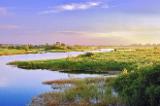Protected Areas
Outside the conservation community, “protection” is commonly spoken of as an either-or condition, and not without reason. The rise of the land trust movement, for example, has led to a burgeoning effort to conserve lands and waters in the face of any number of imminent threats, particularly development pressure or habitat loss and fragmentation. In the absence of any safeguards, even a modest level of protection can be a boon.
However, in practice, land protection is likely best viewed as a continuum encompassing a range of factors that vary from one “protected” area to the next. Most significant among these variables are:
- Management status (that is, the intent, commitment, capacity, and compatibility);
- Ownership;
- Permanence; and
- Landscape condition and integrity.
The discussion that follows will explore each of these in turn, but it’s worth noting that the question of conservation values looms large in any discussion of protection status. That is, what is it we’re trying to protect in a given place?
The reasons for conserving precious places are numerous -- safeguarding biodiversity and ecosystem integrity, protecting open space and rural land uses, providing recreational opportunities, protecting and maintaining essential ecosystem services -- and none of these goals need be seen as mutually exclusive. But identifying the goals for and uses of protected lands does much to determine the relative level of security they enjoy.
IUCN Definition
At its 2008 World Conservation Congress, the International Union for Conservation of Nature adjusted its definition of “protected area” to be:
A clearly defined geographical space, recognised, dedicated and managed, through legal or other effective means, to achieve the long-term conservation of nature with associated ecosystem services and cultural values.
This new definition exchanges the “conservation of nature” for the earlier “conservation of biodiversity.” The change of phrasing may seem relatively slight, but it provides more flexibility in defining a protected area by tacitly acknowledging that some lands may benefit conservation, even though their use and management as, say, a low-impact recreation area, a military training ground, or a sustainably managed farm or forest, does not focus primarily and explicitly on the preservation of biological diversity.
More on Protected Areas
-
National Conservation Easement Database
The National Conservation Easement Database (NCED) is the first national database of conservation easement information, compiling records from land trusts and public agencies throughout the United States.
-
Parks and Protected Areas
Author Jonathan Adams notes, "Parks and protected areas remain the bedrock of conservation efforts worldwide, and for good reason. Parks work. Parks are about hope. But too often the parks are symbols of fear and despair, statements not about the future but about attempts to hold back the tide of change."










